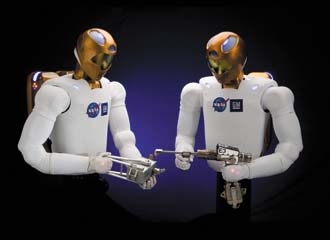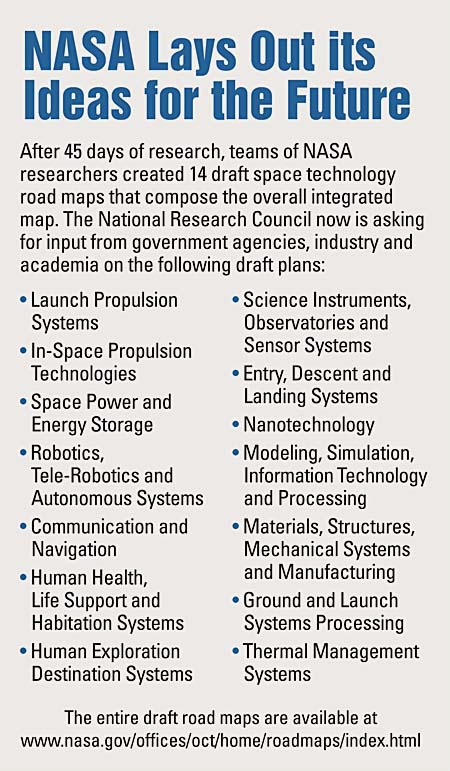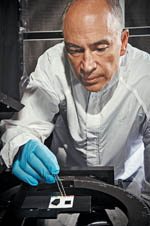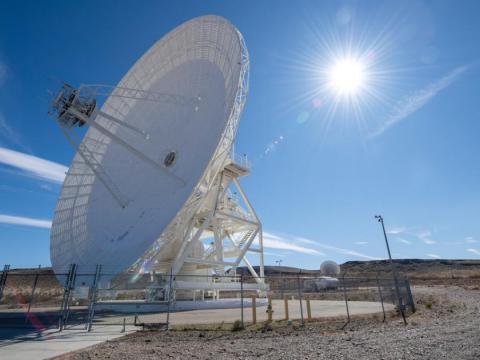Space Agency Spreads Its Wings
NASA and General Motors have developed the next-generation dexterous humanoid robot. Called Robonaut2, the android was designed to use the same tools as humans so it can work safely next to humans on Earth and in space.
Draft road maps are first step toward outreach and transparency. 
NASA is responding to criticism that it has become insular in its technology investments by opening its future plans for public debate. Core to these discussions are 14 space technology road maps that the National Research Council is vetting. NASA also is asking other government entities, industry and academia to weigh in to determine if or how the agency’s ideas will benefit all stakeholders.
According to Dr. James Reuther, director, strategic integration, Office of the Chief Technologist, NASA, the agency’s resources in recent years have been spent primarily on mission-specific technologies. This approach caused top U.S. government officials to question the agency’s relevance to the government specifically and to the national economy as a whole. As a result, NASA reviewed current investments and decided to call for more input.
“The OCT [Office of the Chief Technologist] has to look out for technology programs across all of NASA. One of the criticisms from the administration, Congress and other agencies of what NASA has been doing is that it has been insular with regard to what technologies it invests in and not really thinking about its role in the bigger picture as a government agency,” Reuther says. “If NASA is going to work with government and industry and collaborate with academia as part of the technology engine for the country, we need to have a broad spectrum of technology investments that, while connected to NASA, allow us to create a pipeline of people and ideas.” Another goal is to ensure that the agency’s operations are transparent, he adds.
To address this issue, the OCT chose to examine its current technologies, call for a consensus among its own personnel, vet specific topics through the National Research Council (NRC) and then call for even more input by opening up for public review those technologies it believes valuable to pursue.
Initially, there was some debate about how many road maps to draft, but after reviewing NASA’s past road maps, some general technology areas popped out again and again, Reuther relates. While the themes of past road maps are touched upon in the new draft documents, they do not mirror past road maps, he emphasizes. The teams focused on space technology within NASA, which falls into two categories: space exploration and space science. The criteria for making it into one of the 14 road maps included where the experts anticipated significant technology advances, where substantial improvements were needed, and what reasonably could be started within the next 20 years, he explains.
To begin this process, teams of six NASA experts in their technology areas were tasked with scouring the NASA strategic plan and mission directorates and identifying technologies that will benefit more than just the agency. They were encouraged to “think outside the box” and even come up with ways to leapfrog ahead using technologies that currently may not exist to achieve a long-term goal. The topics were not to be a list of priorities, but rather a comprehensive inventory of all the technologies in which NASA could invest. The teams had 45 days to develop these investment ideas and write draft space technology road maps.
“The goal was to give the NRC a good starting point to choose NASA’s investments in these areas and not overlook anything,” Reuther explains. “They are more of a list of potential investments, but they do not reflect what we will do because they will have to be prioritized and there would have to be some recognition of cost and time frame. It’s not possible to pull that together in 45 days, and it wasn’t the teams’ focus since we wanted the NRC to step in and think about the prioritization and some of the bigger picture external to NASA priorities.”
At the 45-day mark, the draft road maps were examined by a red team composed of representatives from the OCT’s office from each mission directorate. These teams had 30 days to review the road maps and depose the specific technology area teams to point out any flaws in the draft road maps. More than 600 review comments across the 14 road maps were received. Everyone on the teams was deposed, and a thumbs-up or thumbs-down decision was made on every comment. The vast majority of the suggested changes pointed out new ideas.
“I would challenge anybody who is tech savvy to take any one of the NASA products and say, ‘Here are things you didn’t think about,’ or ‘Here are things you should have dropped off.’ There are many angles to these problems. There is not a one-size-fits-all approach, and there is not an opinion that fits all,” Reuther says.
The 14 draft space technology road maps are part of NASA’s integrated technology road map, which includes both pull and push technology strategies; it covers a range of approaches to advance current U.S. capabilities in space.
As of the beginning of this year, the road maps had gone through a full internal NASA review, but there had been no outside review, prioritization or budgets attached to them. After the NRC review, NASA will narrow down the ideas to be able to concentrate fully on each one. During 2011, the NRC will conduct public workshops and review panels, and these will weigh heavily in updating these road maps, Reuther says. “So when the next review occurs about why we are making these particular investments, we can point to the external review,” he relates. “We will also whittle these down because some are very far out—warp drive and teleportation, for example—to think about all the technologies that would be needed.” 
A number of the road maps include technologies that would have a significant impact on the national economy as well as the military. One example is the Space Power and Energy Storage draft road map. Reuther believes this document is one of the most interesting in terms of its significance to the national need for improvements. “If there is anywhere within here where we’re going to be addressing national needs as well as NASA’s needs, I think it’s in space power and energy storage,” Reuther states.
In terms of space travel, NASA is leading the way to improve capabilities in these two areas because enhancements directly would affect the agency’s bottom line when sending objects into orbit. NASA is willing to pay a premium for efficiency, because of the cost of space exploration and experimentation. The larger the mass of an object, the more it costs to send into space.
“Sending solar arrays into space is highly dependent on the mass of those arrays. If we can have more efficient arrays, we get a lower mass and a big benefit. From an industrial/terrestrial perspective, there is also a concern about cost. So the focus is not on achieving the highest efficiency, but NASA will lead the way to show the benefits of these technologies to terrestrial needs if costs can be brought down,” Reuther explains. This also is true in the area of energy storage. Creating low-cost and lightweight ways to store energy especially could help the military by reducing the logistics trail and the amount of weight warfighters must carry with them during missions, he adds.
John Hagopian, principal investigator, NASA, developed a new nanotechnology-based material that is 10 times more effective than black paint. This blacker-than-black material will help scientists gather more accurate scientific measurements in space by blocking out stray light.
The topic of another draft road map that has widespread implications is the Robotics, Tele-Robotics and Autonomous (RTA) Systems document. The team focused on classical areas of sensing and perception, mobility, manipulation, human systems interfaces, autonomous rendezvous and docking, and system autonomy. It identified functional capabilities within topics, including advances in processors, communication, batteries and materials, that have enabled major leaps forward during the past decade. The document also evaluated dozens of NASA missions within the four mission directorates planned to take place during the next few decades, then mapped technology push and pull elements from the RTA core disciplines into those missions. It identified approximately 100 individual technologies that would enable or strongly enhance those missions. 
Reuther points out that one reason to focus on this area is that 20 years ago the United States led the world in robotics research, manufacturing and usage. Since that time, other countries have assumed that lead. Robotics in many U.S. manufacturing plants today were built in other countries. “This is a big problem as we see it. It’s a problem for NASA, and it is a problem for the U.S. space industry,” he states.
This is not to say that the United States is lagging in all robotics areas. It maintains the lead in human-robotics interaction, artificial intelligence and robots, and autonomous robotics operations. This is particularly evident in the military’s use of unmanned aerial vehicles and has been important in exploring Mars. However, more work in this area will be needed to explore other planets or put objects into suborbit. It also is crucial for sending humans beyond low earth orbit and places that humans cannot go.
In many cases, robots that humans can manipulate will be necessary for proximity operations, Reuther explains. “Those are areas where clearly NASA needs to push even further, and we hope to do so with other government agencies as well as the nascent industries and academia that focus on these areas in the United States,” he says.
Communications and navigation are two of the most important aspects of working in space, Reuther relates. As the United States goes farther into space, these two capabilities become more difficult, because the datalinks are limited. This condition will not change until a new way to communicate and navigate is discovered. Optical communications or even X-ray communications show potential, he says.
Some improvements also have occurred in the area of navigation; however, currently in space all navigation is Earth-relative. The farther spacecraft move from Earth, the more difficult navigation becomes. For example, trying to achieve orbital entry to a planet may depend on maneuverability. As a result, scientists must be highly accurate in their projection of the amount of propellant needed to allow the navigation system to achieve entry. Spacecraft may need to carry more fuel if the navigation systems are not as accurate as they need to be. And because navigation is connected to communications on Earth, if navigation cannot be done autonomously, a communication link would have to be established, which puts additional strain on communication systems.
Like many other research organizations, NASA also is interested in pursuing nanotechnology. Reuther shares that over the past decade nanotechnology has bounced in and out of vogue at NASA. Today, the OCT believes that investments in nanotechnology must be made for the future. This research must include more than just carbon nanotubes. “We’re talking about looking at the molecular level and what happens to propellant systems. If we change the way molecules act in propellant, we may get a 10 percent or 15 percent efficiency gain without changing the mass,” he explains.
Nanotechnology covers several different areas. “We have to work at that scale for many systems to realize technology advances in everything from sensors to energy systems to materials to propulsion systems,” Reuther states.
NASA needs high-strength materials, some of which are nano-based. The agency is willing to pay more for stronger materials that do not increase mass. “But if no one is paying for the upfront cost [of research], it won’t work its way into the mainstream,” he adds.
With regard to industry, Reuther encourages companies to become involved in the draft space technology road maps review process. “We want to hear from industry at the workshops the NRC will hold over the next couple of months as well as on the NRC website where they are soliciting comments now,” Reuther states.
The OCT’s Office of Space Technology is particularly interested in partnering with industry and academia, and a number of solicitations will be announced, he adds. “We want to use the limited NASA budget to help industry to get where it needs to be. Industry and academia are asked to partner with NASA to solve mutual problems,” Reuther states.
WEB RESOURCES
NASA Office of the Chief Technologist: www.nasa.gov/offices/oct
NASA Strategic Integration: www.nasa.gov/offices/oct/strategic_integration/strategic_integration_detail.html
The National Research Council: http://sites.nationalacademies.org/DEPS/ASEB/DEPS_059552
http://sites.nationalacademies.org/NRC/index.htm



